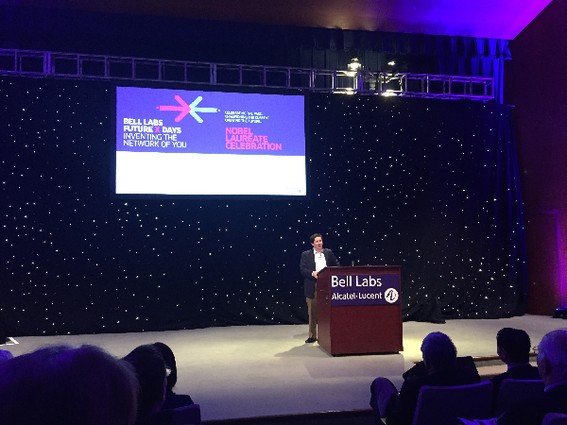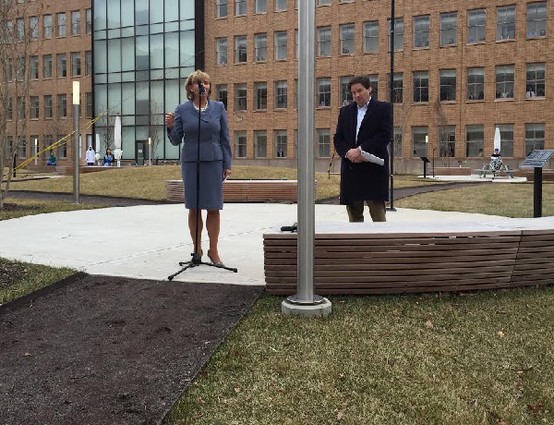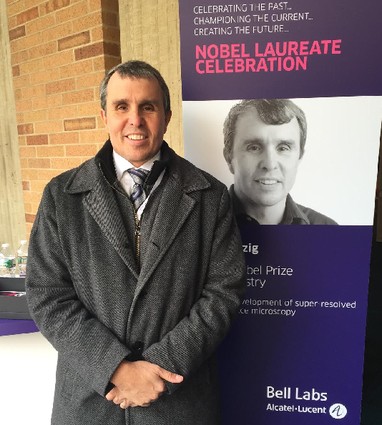In Nod to Its Rich Heritage, NJ’s Bell Labs Honors Nobel Laureates

Nobel Prize winners come from every corner of the world, devising solutions to science’s most complicated problems.
One company can claim eight Nobel Prizes — seven in physics and one in chemistry — as well as countless other awards during its 90-year history. That company is Bell Labs, and it commemorated this rich legacy with the dedication of its Nobel Laureate Garden, in Murray Hill on April 8.
The eight Nobel Prizes were shared among 13 Bell Labs scientists, all of whom had two things in common: They received their prizes while working on research in telecommunications and they did much of their work in New Jersey.
Formerly owned by AT&T, when the latter was a New Jersey and national powerhouse, Bell Labs is now owned by Alcatel-Lucent, and will soon be acquired by Nokia.
The garden consists of eight circular seating areas representing the eight Nobel Prizes, with room to add more should company scientists win more prizes, a possibility that Marcus Weldon, Bell Labs president and CTO, did not dismiss. “I don’t think I’ll be around, but maybe that’s the next innovation,” he said.
Those honored were: in chemistry, Eric Betzig (Nobel Prize in 2014); and in physics, Willard S. Boyle and George E. Smith (2009); Robert B. Laughlin, Horst L. Störmer and Daniel C. Tsui (1998); Steven Chu (1997); Arno A. Penzias and Robert W. Wilson (1978); Philip W. Anderson (1977); John Bardeen, Walter H. Brattain and William B. Shockley (1956); and Clinton J. Davisson (1937).
Several surviving Nobel laureates returned to Bell Labs for the ceremony.
The event included speeches from local political leaders, such as N.J. Lt. Gov. Kim Guadagno and U.S. Rep. Leonard Lance; and there was an acrobatic troupe whose performance featured jumping stilts, pole climbing and fire dancing.

Guadagno highlighted New Jersey’s place in the world of technical innovation. “This is a garden that is a garden of remembrance. This is a garden of challenge. This is a garden where people at all ages will be able to come and say, ‘We did it here.’ And if we did it here in the past, we can do it again.”
Keynoting the garden opening was Betzig, whose address chronicled his early work at Bell Labs, a later stint at his father’s machine business, and his eventual return to research in microscopy.
Betzig began at Bell Labs after earning his Ph.D. at Cornell. He was hired by Nobel laureate Horst Störmer to research near-field microscopy. While his early work at Bell Labs was successful, Störmer felt constrained by the federally mandated breakup of AT&T and by the low quality of research that built upon his work. He left Bell Labs in 1996, unsure of what to do next. “I had no plan B, I had no idea what I wanted to do with my life,” Betzig said.
He fell back on his father’s machine shop in Michigan, where he became vice president of research and development, inventing Flexible Adaptive Servohydraulic Technology (FAST). His technology was not a commercial success, however, and he left after two years. The experience left him unfulfilled and longing for the research-oriented life that he had had at Bell Labs.

Betzig then connected with Harald Hess, a friend from his Bell Labs days, with whom he continued his work on microscopy. Hess had taken his equipment with him after leaving Bell Labs, and he and Betzig used that equipment in Hess’ California apartment to conduct their research.
Their big break came when Betzig read a Nobel Prize-winning paper by laureate Martin Chalfie (chemistry, 2008) about green fluorescent proteins from jellyfish that could be used in cells to illuminate proteins. The technique allowed Betzig to build on his previous work toward developing a technique called “photo-activated localization microscopy” (PALM), which won him the 2014 Nobel Prize in chemistry. PALM is a technique that allows images to be obtained beyond their diffraction limit. Betzig referred to his prize as “bittersweet,” as he believes that Hess deserved to be recognized by the Nobel committee as well. “This prize is his as much as it is mine,” he said.
In his speech, Betzig noted the opportunity that Bell Labs had given him at a young age, and he voiced his dismay at the lack of similar research organizations today. “When I got started, I got a f***king lab at 28 years old. There are just too few opportunities today for people to have that opportunity today.” He said that he was lucky to be working now at the Janelia Farm Research Campus, an institution modeled after Bell Labs that is part of the Howard Hughes Medical Institute. He listed other labs that have either scaled down or no longer exist, such as Sarnoff, Xerox PARC, Yorktown and Almaden.
“All of these places where people can have young careers like that are gone. And if there’s one thing I can preach on the Nobel soapbox: Look at the freaking successes of these places! If you give people a challenge and a problem in front of them, and you leave them alone, and they are motivated and they are full of piss-and-vinegar to try to solve that challenge, great things happen … and that’s the kind of environment we have to foster in other places.”

